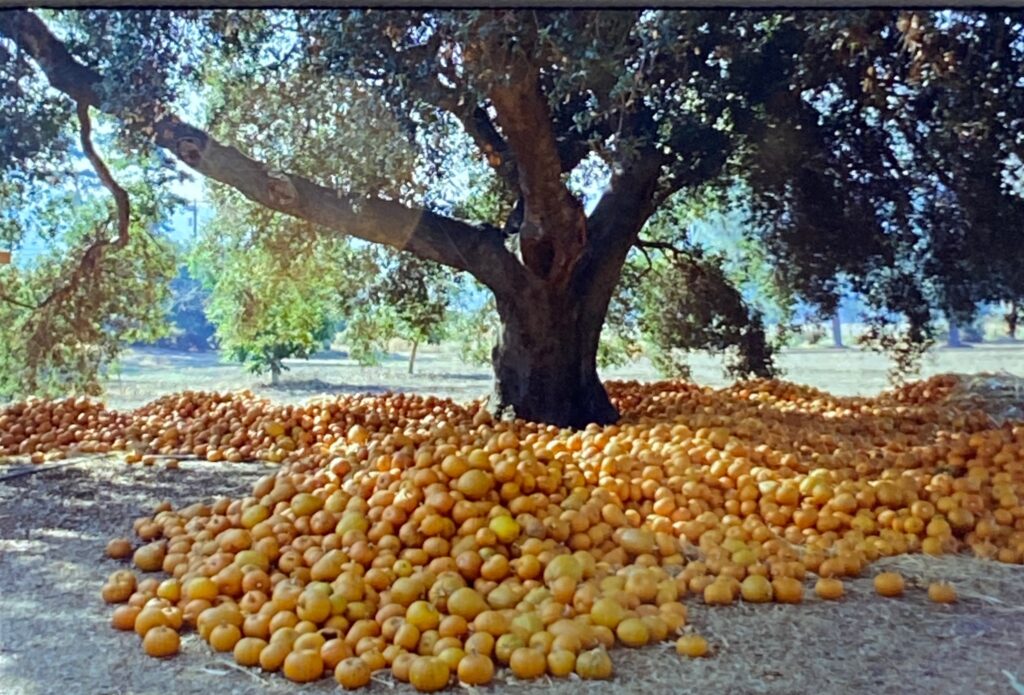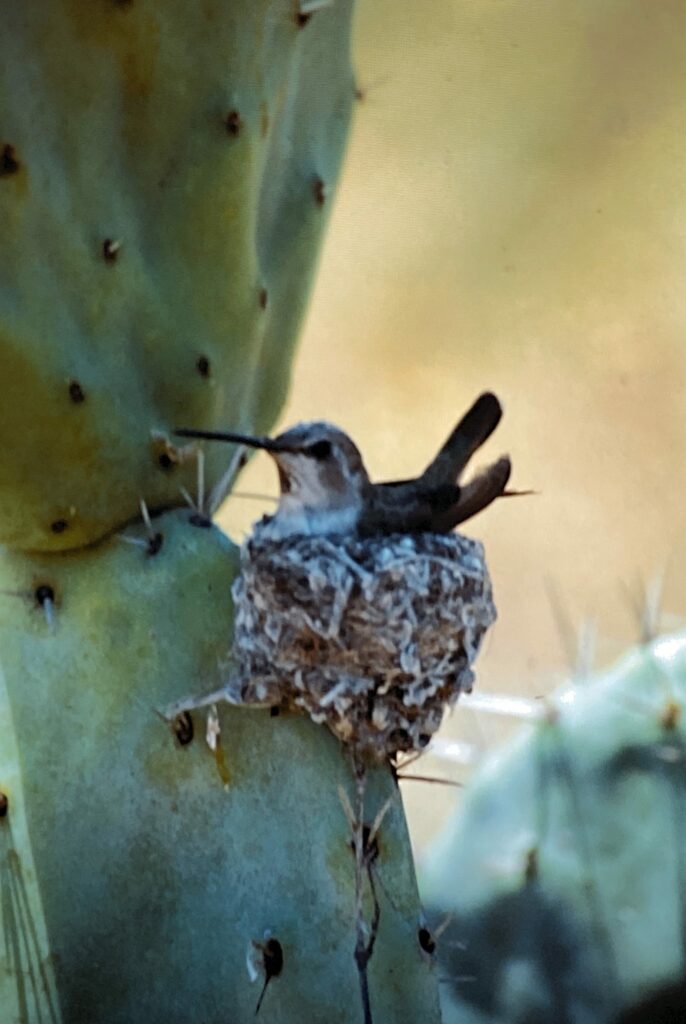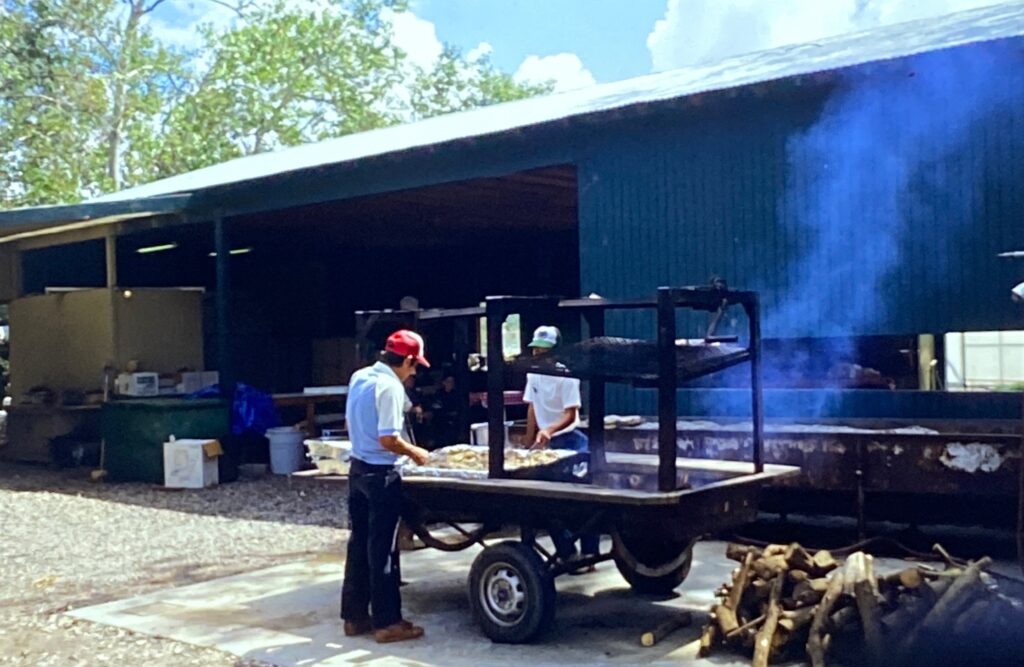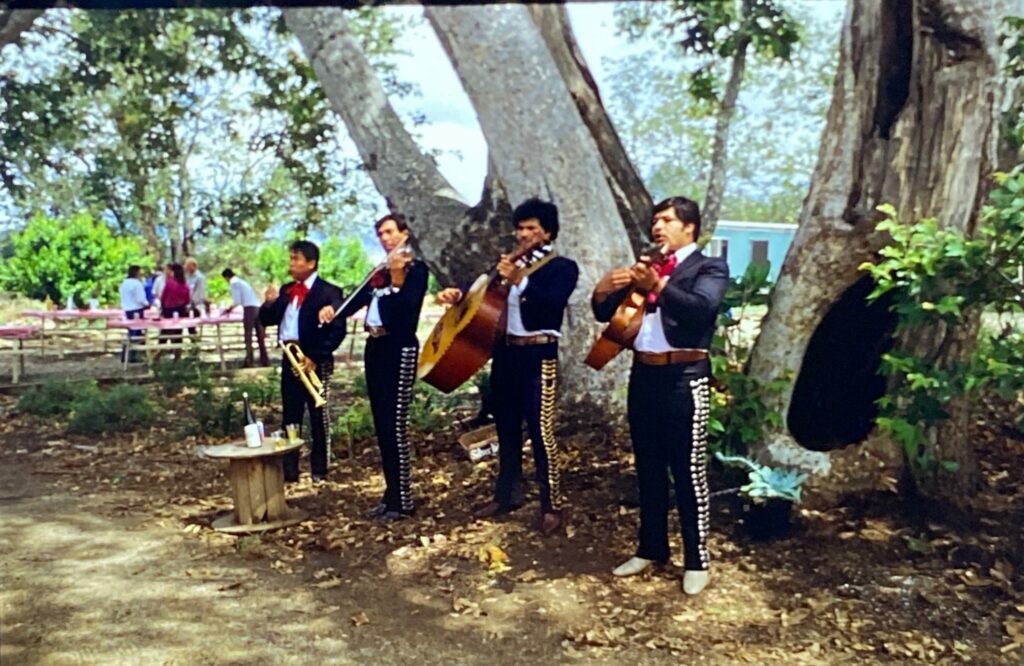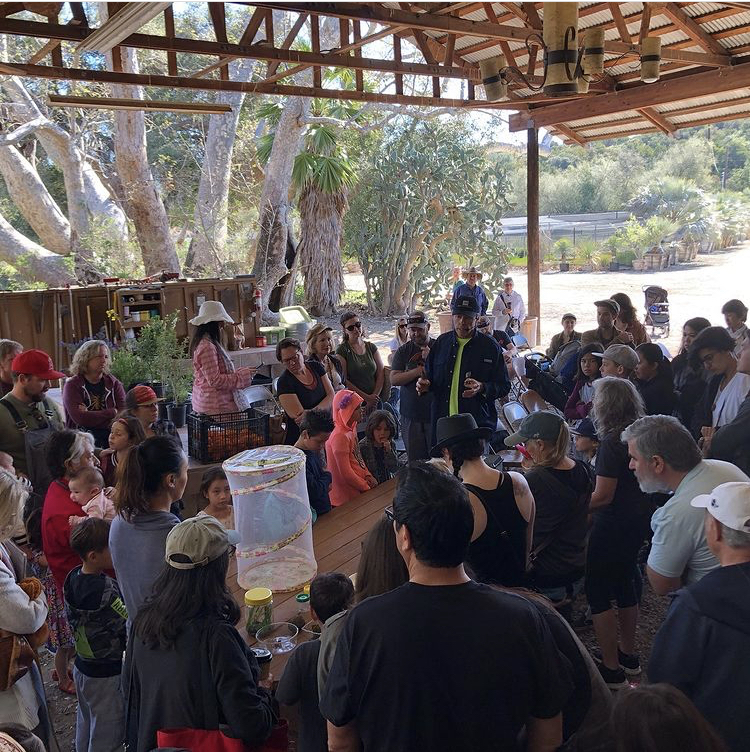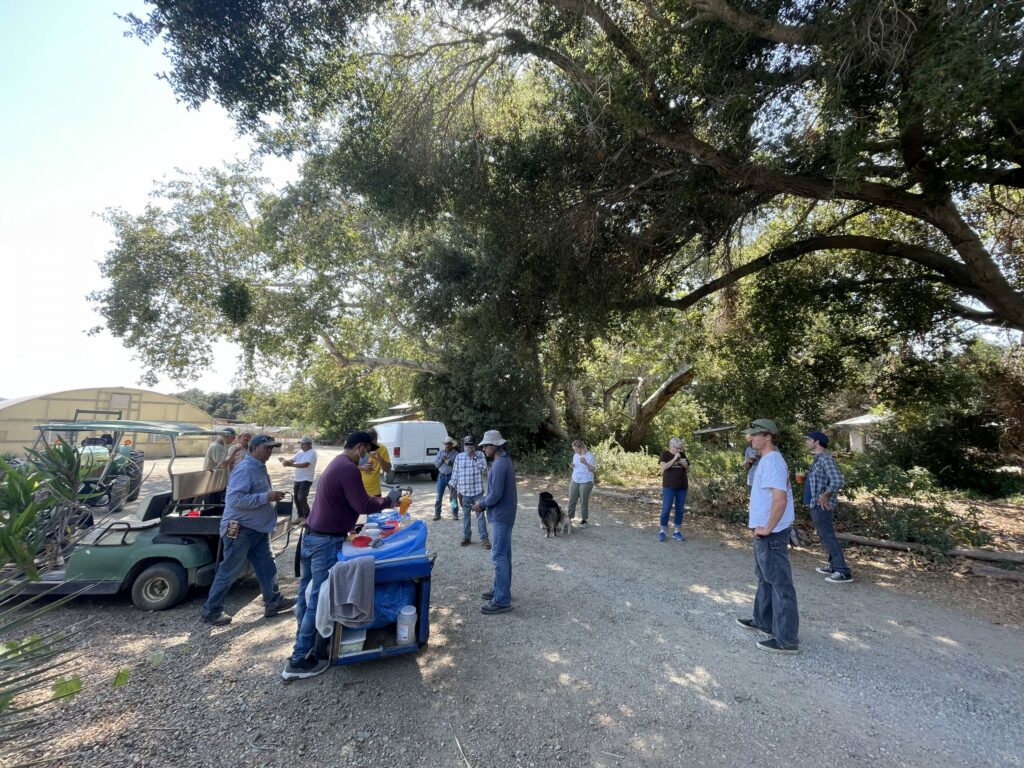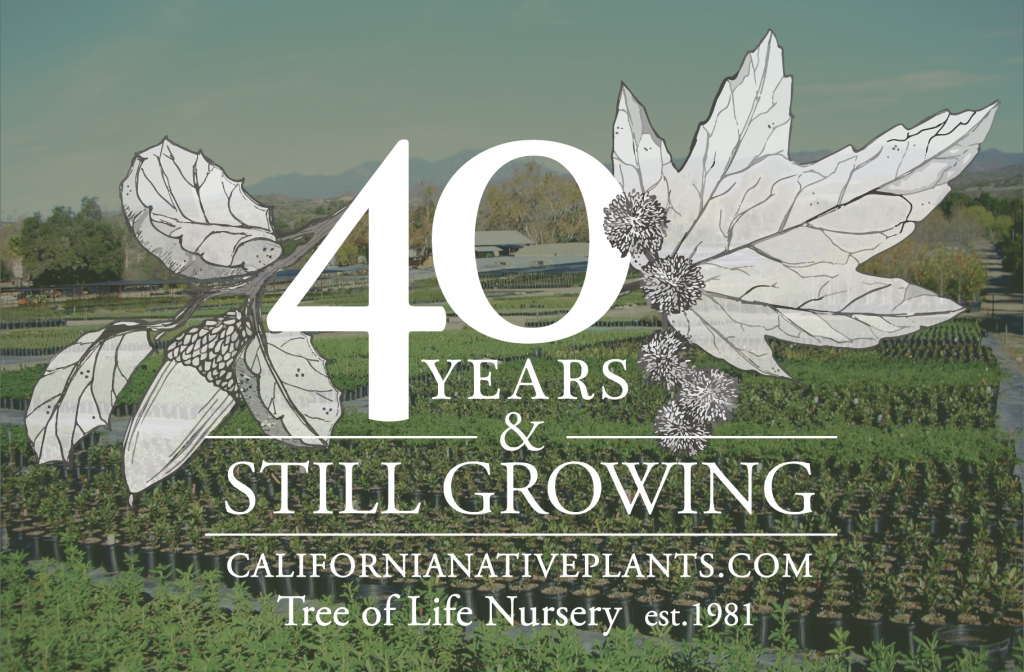
The story of Tree of Life Nursery is really a story of people and passion. And plants. California native plants and the land we occupy for growing, plus our team of friends and colleagues, including our loyal customers. 2021 marks the official 40-year anniversary of the partnership between the owners Jeff Bohn and Mike Evans. Mike founded the original company under the name Tree of Life Nursery and Landscape in 1977. Through a mutual friend and native plant expert, Mr. Art Tyree, (who learned from Mr. Theodore Payne himself) Jeff and Mike met in 1979 and discovered they had a lot in common; beach culture, surfing, the outdoor life, functional landscapes, sustainable gardens, landscape design, nursery experience, and a love for California native plants. Their story of building a nursery, a business, and a lifestyle will be told in a series of monthly essays to be published through 2021.
ESSAY #4, JUNE 2021 – IDEAS, ENDEAVORS, DIRECTIONS, & DEPARTMENTS
Hummingbirds visit lots of different flowers. Somewhere I read the average number for an average day in the average life of an average hummingbird and I was blown away. Over 1000! Because of their high metabolism, they basically eat all day, sampling from a rich variety of flowers.
For these essays, we set due dates. Right now my desk seems a mess but each rock, fossil, seed pod, stone tool, pine cone, carving, sea shell, photo, clay pot, postcard, trinket, rusty bolt, magazine, or book has its own story, with space in the middle for my laptop. All this in a room of bookshelves containing Seri figures, Indian baskets and pottery, found rocks (including bowls of Big Sur jade), dried flowers, a couple hats, and of course books on plants, places, people, history and ideas in nature, all encompassed by walls hung with plein air art, maps, certificates, photographs, native weavings, shell necklaces, a few cool display knives, and a coffee cup, backpacks, camp gear, bags of maps, bags of bags, collected seed (needs processing), and a guitar taking their places here and there, next to a water bottle and my flip flops.
Outside my window is a whole world of garden intrigue calling me even now to do some spot watering or tip pruning, feel the breeze and listen for birds, hang out with Dakota, catch a little sun, (the fountain could use cleaning), or pull some weeds, all reminiscent of friends from boyhood days standing outside calling, “come out and play.” Which I will do, but now I have a due date and a time to write.
If you try a lot of stuff, something’s bound to work. At Tree of Life we are singularly passionate about native plants, and with them, indeed through them, we strive to provide inspiration, information and connection to nature. But over our 40-year history, you could say we have sampled from many different flowers within one big garden.
We started in the late 70’s growing a simple list of the most noteworthy native plants. We grew what we hoped would sell and we promoted many plants most people were not familiar with. As our reputation and business increased, we started growing some plants on contract, a new endeavor, a new “department.” Rough and ready landscape plants, mostly for slopes and out-of-the-way plantings in large quantities, while we continued to promote refined natives for visible planters at the front door.
Then our inventory split into two categories, plants for landscaping, and plants for ecological restoration (back then called revegetation). A new endeavor. Most reveg was centered around wetlands, so we grew lots of willow, mulefat, cottonwood, elderberry, sycamore, and all the other usual suspects. Pretty solid new department, riparian restoration.
Actually, a big part of our production then centered around wetland reveg. When we got our first inquiry for California sagebrush, buckwheat, black sage, white sage, coastal sunflower, deerweed, and coyote brush, I was flabbergasted! Projects needed container plants of species I considered the basic “default” plant community (coastal sage scrub) – the common one we trek through to reach a canyon, cave, rock outcrop, ledge, big tree, or shrub, where we might actually find something interesting? Turns out the default plant community was also becoming scarce. It was called upland restoration.
Our business was wholesale only, about 50% landscape plants and 50% reveg. We had a lot of unused land so we dabbled in farming on the side. Confession time. There was some hot tip on cantaloupe futures so we planted about 3 acres, all at once, with no buyers lined up. We were going to corner the market, make a killing. To this day, when I smell an overripe melon I am reminded of the thousands that did not sell during those first hot days of summer. We tried organic corn, which actually worked except most people weren’t fond of the little worm they found waving at them when they opened the green husks. One year, we were certain mini pumpkins would be all the rage (about 10 years before they actually were all the rage) and we guessed right, except that ours ripened on Labor Day, two (hot) months before Halloween. Note to self: plant seed later in the season. To this day, I don’t like the smell of rotten pumpkins either. We gave up on commercial farming. Leave it to the folks who make it look easy, because it’s not.
All the while we were building new shade houses, growing beds, and greenhouses. We developed a laboratory and facilities, and hired an expert to produce a beneficial soil inoculant containing endomycorrhizal fungi, good guy microorganisms that live in soil root zones and help native plants. This program was highly successful for our own use in house, but we fell short on marketing a commercial product. Mycorrhizae was a new department in our young business. We coupled it with our rudimentary plant pathology lab in a vintage travel trailer.
Oh yeah, we also planted a 2-acre field of a most delicious strain of edible cactus (Opuntia ficus-indica), but harvesting and selling the nutritious pads and fruit we did not get around to. We ate plenty ourselves, but not two acres worth. So we failed to make a million as the local purveyor of nopales and tunas, but the field was picturesque, like old Mexico in San Juan. And when bulldozed into a heap, what a great heap!
Back at the ranch we were honing in on native plants as the general public was finding us and wanting our product. “Wholesale Only” read the sign, but thankfully, some folks drove past the sign and convinced us that their money was as good as anyone’s, and their enthusiasm much better, so we developed policies to accommodate sales to the general public. Special days, special hours, and we did not make it easy. We had always hoped to supply local nurseries and garden centers, but they were not very interested and besides, many were going out of business because big box retailers were moving in. Sales to this new customer base became a new department all its own. Then our barn burnt down.
We got on the straw bale trail by advice of a friend and never looked back. Over time, we built our New Barn, then our Roundhouse for retail, next our Oficina and finally Casa La Paz using plastered straw bales as the wall system. We became local authorities on this fascinating building alternative, hosting workshops, tours, and providing instruction. Huell Howser even did his California Green episode on straw bale construction at our nursery.
We started selling books and seeds and related items and we made it easier for the general public to find us. Regular hours and dedicated staffing helped. Retail was becoming a very important department for us.
All along we were trying new plants and also contract growing plants which originated on particular job sites, thus establishing site-specific contract-grown reveg plants as a separate wholesale department. This involved special collections of seed and cuttings, extensive record keeping and accountability in propagation, acclimatization, and follow up for second and third generation collections from established mother plants. We specialized in this and still do.
A few years later, we revived our mycorrhizal department with fresh research and techniques and a new expert conducting experiments, and testing other beneficials. At conferences and in the world of ecological restoration we were recognized as experts in a very pragmatic sense. I guess we had built an actual R & D Department at a working nursery.
The wholesale plant world was changing, with non-native plants being touted as solutions for water savings, the recession was taking its toll on nurseries, and commercial horticulture was in a tailspin. We hung in there, encouraged by the enthusiasm of our native plant public, so we re-upped our efforts in retail. With ‘Casa La Paz’ fully operational, we stocked it with more books and other gift items around the theme of nature and the restorative healing experiences of natural gardening. This theme was becoming increasingly important.
At Casa La Paz we started our live outreach series: free workshops every Saturday morning. This program is incredibly popular and perhaps our most iconic hands-on activity is our Christmas Wreath Workshop, now going into its 18th year. (We had to take the entire workshop department online for over a year during the Covid pandemic, and we learned a fair bit, reaching tons of new people online.)
A few years ago, we looked around and noticed we were aging, both as a business and as a staff, especially in the office. We needed new people to take on new ideas, endeavors, and directions; maybe even start a few new departments. And we needed new sources of income from our field of commercial horticulture, but our business objectives had never fit into any conventional definition. So we stuck with our original goal: 1) to create a lifestyle for our team and our customers and 2) to have fun doing it. But it would be no fun to have to shut the gate, call it quits. The business was desperate for new life, new energy, and income.
We interviewed and hired keen, capable, committed, lively, passionate youth. Some of our interview questions a few years ago seem clumsy now, such as “Do you know how to post on Instagram?” One then another and another – we kept hiring. The first few had to bond all by themselves with the oldsters, but now they are many and we have all become one big happy diverse family.
We started pounding our message on social media, went online with workshops, initiated a YouTube channel, crossed the 5000 follower mark on IG, developed design style guides, revamped our website, and managed to stay true to our first love, native plants with lifestyle and fun. We upgraded inventory, sales, accounting, and propagation database programs. We started a little mail order department. We fixed our old golf carts.
Our departments have grown to include “TOLN Design” custom garden design and build, and “Naturescape” where we partner with Moulton Niguel Water District, installing their turf replacement native gardens. We also provide garden tune-ups and maintenance as follow up on our landscape services.
We built “La Finca” where we produce and sell organic vegetable transplants and we’ve established a joint venture with South Coast Farms, food growers who really do know what they’re doing. Their “U-Pick Strawberry” program is a big hit every year bringing new customers to our place. In the back 40, exciting new departments include “Micropropagation,” where we equipped a real live scientist with a real live tissue culture lab so that rare species can be propagated for conservation and other hard to propagate plants can be produced.
We’ve ramped up our outreach department through social media and in-house interpretive signage, rethought workshops and messaging in general, and determined to make Tree of Life a transformational experience for everyone. We work hard on quality, and how we display our plants, settling for nothing less than a very attractive finished product, because at the end of the day, we grow and sell native plants.
I guess we have high metabolism and need to keep moving from bloom to bloom. Our customers and colleagues make it worthwhile. Nature gives us inspiration. We have an incredible team! Our Tuesday morning staff meetings have become reports of the week’s flower foraging, and plans for our next forays into flower fields. We even discuss due dates for these essays. Thanks for reading.
Too dark now to clean the fountain, but Koda and I need a walk. So outside we will go.
Solomon wrote that we should basically use wisdom and try a lot of stuff because something will work out. But mostly, we should do it with all we’ve got, and then enjoy the fruits of our labor.
“Wisdom is a tree of life to those who take hold of her; those who hold her fast will be blessed. Ship your grain across the sea; after many days you may receive a return. Invest in seven ventures, yes, in eight; you do not know what disaster may come upon the land. Sow your seed in the morning, and at evening let your hands not be idle, for you do not know which will succeed, whether this or that, or whether both will do equally well. Whatever your hand finds to do, do it with all your might…” Proverbs 3:18; Ecclesiastes 11:1,6; 9:10
